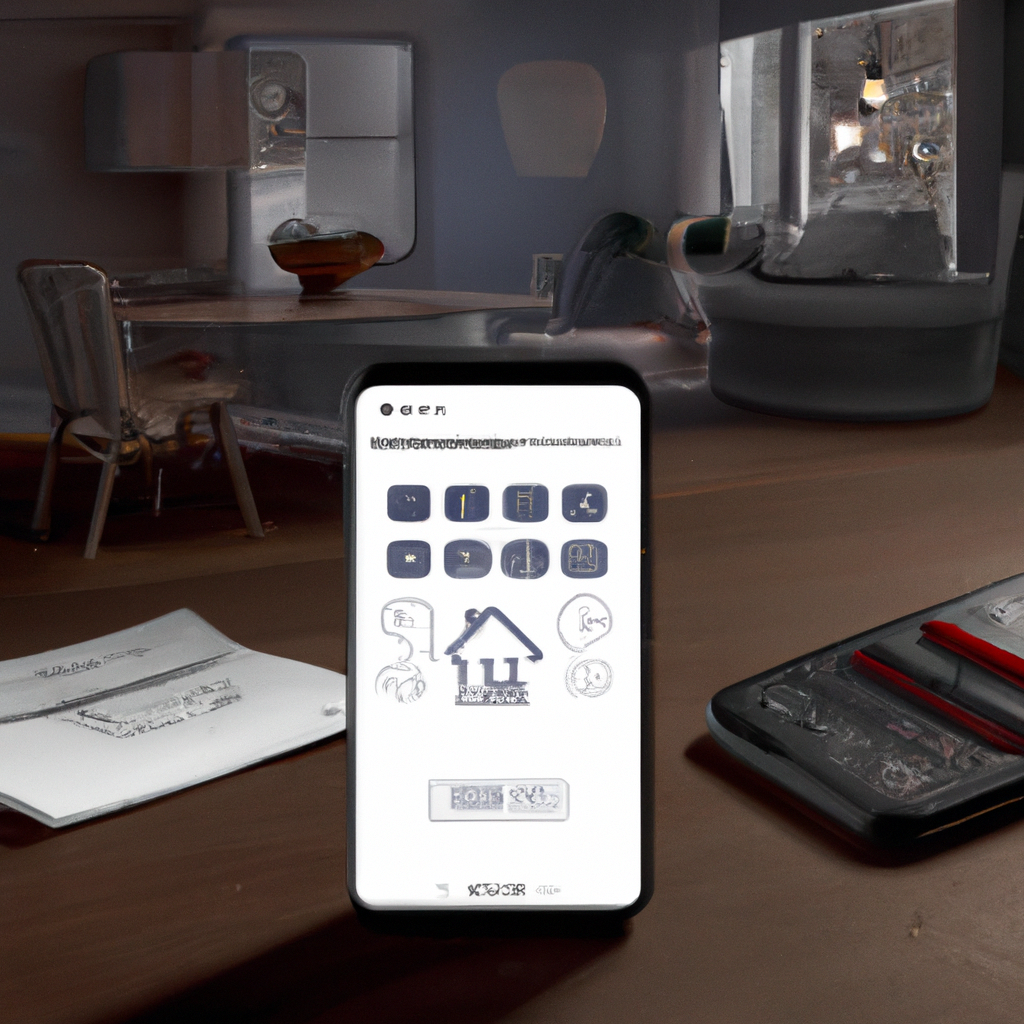Imagine being able to control your entire smart home with just a tap on your smartphone screen, no matter where you are in the world. It sounds like something out of a science fiction movie, but the reality is that it is now possible. With the advancements in technology, you can now effortlessly control your smart home automation remotely using just your trusty smartphone. Whether you want to turn off the lights, adjust the temperature, or lock the doors, all you need is your smartphone and an internet connection. Say goodbye to the days of rushing back home to make sure everything is in order – now, you can have full control of your smart home right at your fingertips. Yes, you absolutely can control your smart home automation remotely using a smartphone! In fact, it’s one of the main benefits of having a smart home system. With just a few easy steps, you can set up your smart devices, choose the right smartphone, install the associated mobile app, and start controlling your home automation system from anywhere in the world.

1. Setting Up a Smart Home Automation System
Setting up a smart home automation system may seem daunting at first, but it’s actually quite simple. The first step is to choose the right smart home automation hub. This hub acts as the central control point for all your smart devices and allows you to manage them through a single interface. There are many options available on the market, so take some time to research and find one that meets your needs.
Once you have chosen a hub, the next step is to install your smart devices. These could include smart lights, thermostats, security cameras, door locks, and more. Make sure to follow the manufacturer’s instructions for each device to ensure a smooth installation process.
After all your devices are installed, it’s time to connect them to the hub. This can usually be done through Wi-Fi or Bluetooth, depending on the specific devices and hub you have chosen. Follow the hub’s instructions for connecting each device – this typically involves scanning for nearby devices and pairing them with the hub.
2. Choosing the Right Smartphone for Remote Control
Now that your smart home automation system is set up, it’s time to choose the right smartphone for remote control. The first consideration is compatibility with your home automation systems. Some systems may only work with iOS or Android devices, so make sure to check the requirements before making a purchase.
Additionally, consider the operating system of the smartphone. iOS and Android are the most popular options, and both have their own benefits. iOS devices are known for their smooth performance and seamless integration with other Apple products, while Android devices offer a wider range of options and customizable features.
Lastly, look for features that will enhance your remote control experience. These could include a large and vibrant display, fast processor, long battery life, and compatibility with other smart devices or voice assistants.
3. Installing and Configuring the Associated Mobile App
Once you have your smartphone, you’ll need to install and configure the associated mobile app for your smart home system. Start by downloading the app from the respective app store – simply search for the app name and follow the installation prompts.
After the app is installed, you’ll need to create an account. This usually involves providing your email address, creating a password, and agreeing to the terms of service. Make sure to choose a strong password to protect your account and ensure the security of your smart home system.
Once your account is created, you will typically be prompted to connect the app to your smart home system. This can usually be done by following the in-app instructions and entering your hub’s information. The app will then scan for connected devices and display them in the interface.
4. Understanding the User Interface of the Mobile App
Now that the app is installed and connected to your smart home system, it’s important to familiarize yourself with the user interface. The main component of the app is the dashboard, which provides an overview of all your connected devices and allows you to access their controls.
Navigating the dashboard is usually quite intuitive – you can swipe left or right to switch between different sections or tap on specific devices to access their controls. Take some time to explore the app and get comfortable with the layout and organization of the interface.
In addition to accessing and managing devices, most mobile apps also offer customization options. This means you can personalize the controls for each device according to your preferences. For example, you can rename devices, group them together for easy control, or create custom scenes that activate multiple devices with a single tap.

5. Controlling Smart Home Devices Remotely
With your smartphone and the associated mobile app, you can now start controlling your smart home devices remotely. One of the key benefits of remote control is the ability to access your devices from anywhere in the world, as long as you have an internet connection.
To access your devices remotely, simply open the mobile app and navigate to the dashboard. From there, you can tap on any device to access its controls and make adjustments. For example, you can turn lights on or off, adjust the temperature on your thermostat, or view live camera feeds.
In addition to managing individual devices, mobile apps also offer the ability to schedule and automate tasks. This means you can create routines or schedules that automatically activate or deactivate certain devices at specific times. For example, you can set your lights to turn on at sunset or have your thermostat adjust to a specific temperature when you arrive home.
6. Utilizing Voice Control for Remote Automation
To further enhance your remote automation experience, consider integrating voice assistants into your smart home system. Voice assistants, such as Amazon Alexa or Google Assistant, allow you to control your devices using voice commands.
To integrate a voice assistant, you’ll need to follow the instructions provided by the assistant’s manufacturer, as the process may vary. Generally, you’ll need to install the assistant’s app on your smartphone, connect it to your smart home system, and then link it to your desired devices.
Once your voice assistant is set up, you can start automating tasks with voice commands. For example, you can say “Alexa, turn off the lights” or “Ok Google, set the thermostat to 72 degrees”. This hands-free control is not only convenient but also allows you to control your devices from a distance, even when you don’t have your smartphone with you.

7. Enhancing Security for Remote Control
With any smart home automation system, security is of the utmost importance. To ensure the safety of your smart home system when controlling it remotely, there are several security measures you can implement.
Firstly, implement strong passwords for both your mobile app account and your smart home system hub. Avoid using common or easily guessable passwords and consider using a password manager to securely store your passwords.
Secondly, enable two-factor authentication whenever possible. This adds an extra layer of security by requiring a secondary form of authentication, such as a fingerprint or a unique code, in addition to your password.
Lastly, regularly monitor the access logs of your smart home system to check for any suspicious activity. Most mobile apps and hubs have a log feature that allows you to see which devices were accessed and when. If you notice any unauthorized access, take immediate action to secure your system.
8. Troubleshooting Remote Control Issues
Sometimes, you may encounter issues when trying to control your smart home devices remotely. Here are a few troubleshooting tips to help you overcome common problems.
Firstly, check your internet connectivity. Remote control relies on a stable internet connection, so make sure your smartphone has a strong Wi-Fi or cellular connection. If the connection is weak, try moving closer to the router or connecting to a different network.
Secondly, ensure that your devices are compatible with remote control. Some older or less advanced devices may not have the capability to be controlled remotely. Double-check the specifications and requirements of each device to ensure compatibility with your smart home system.
Lastly, make sure to keep both your device’s firmware and the mobile app up to date. Manufacturers frequently release updates that fix bugs and improve performance, so regularly check for updates and install them as necessary.

10. Considering Privacy and Data Protection
When utilizing smart home automation remotely, it’s important to consider privacy and data protection. Smart devices collect and transmit data, so it’s crucial to take steps to protect your personal information.
Start by reviewing the privacy policies of your smart home system, mobile app, and associated devices. Understand what data is being collected, how it is used, and who has access to it. Choose systems and devices from reputable manufacturers that prioritize data security and have clear policies in place.
To secure data transmissions, make sure your home Wi-Fi network is password-protected and encrypted. This will prevent unauthorized access to your network and the data transmitted between your devices.
Lastly, regularly update the firmware of your devices. Manufacturers often release firmware updates that address security vulnerabilities and patch potential breaches. By keeping your devices up to date, you can ensure that you have the latest security measures in place.
In conclusion, controlling your smart home automation remotely using a smartphone is a convenient and efficient way to manage your devices from anywhere in the world. By following the steps outlined here, you can set up your smart home system, choose the right smartphone, install the mobile app, and start enjoying the benefits of remote control. From accessing and managing devices to scheduling and automating tasks, the possibilities are endless. Just remember to prioritize security, troubleshoot any issues, and protect your privacy and data. With these considerations in mind, you can confidently embrace the convenience and control of managing your smart home automation system remotely.










